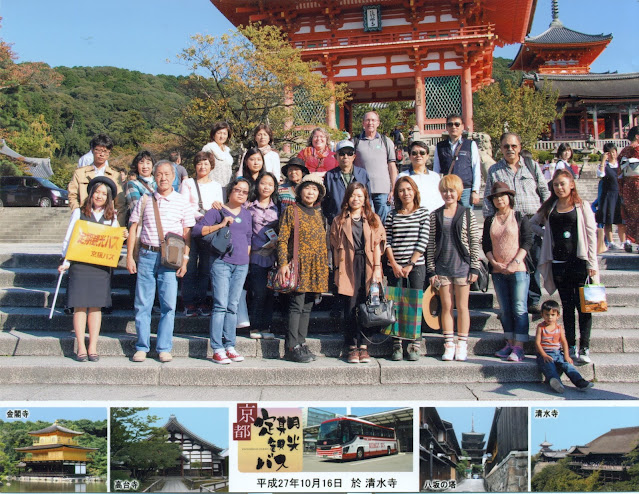 |
| Above, Kyoto's famous Kinkaku-ji "Golden Pavilion" in 2015. Photo by Armand Vaquer. |
In the years just prior to the outbreak of the COVID-19 outbreak, the Japanese city of Kyoto were suffering overtourism of too many tourists, some of them ill-mannered. The businesses loved the revenue the generated, just didn't particularly like the tourists.
I was last in Kyoto in 2015 and from what I saw of the numbers of tourists, I understood how the residents felt. We visited with an organized bus tour company.
Then the pandemic hit and Japan closed its borders to foreign tourists. The country will fully reopen October 11. Many in Kyoto are happy this will be happening, but with some reservations.
 |
| Above, the Kyoto tour group photo at Kiyomizu-dera in 2015. |
TODAY posted an article on Kyoto and what they are and aren't looking forward to when the country reopens.
They start it off with:
TOKYO — In the months before March 2020, the food sellers in Kyoto’s Nishiki market often wished for an end to the seemingly endless stream of photo-hungry visitors from abroad who always seemed to be underfoot.
“We weren’t used to foreign tourists,” said Mr Nobuyuki Hatsuda, who leads a business alliance promoting the shopping street in the city centre, where vendors sell a dizzying array of traditional Japanese foods, carefully displayed and attractively packaged.
Nishiki has long been a working market, and the parade of visitors — rifling through the meticulously arranged merchandise, haggling with frazzled shopkeepers and blocking storefronts with their luggage — interfered with the flow of daily business, driving away locals who had long done their shopping on the street.
But then the pandemic hit. The tourists — along with their money — evaporated, and sellers had a change of heart, said Mr Hatsuda, who sells kamaboko, a fish cake often formed into delicate pink and white loaves.
“We realised that we can’t choose our customers,” he said. Other than China, Japan had maintained the strictest border controls of any major economy. Since the start of 2021, fewer than 800,000 foreign visitors have set foot in the country. As other countries began welcoming tourists back in numbers close to their pre-pandemic highs, Japan let only a trickle of travellers in.
The country eased restrictions on trips for business and study in the spring, but as of September, it was still limiting tourism to travelers on package tours who were willing to negotiate a labyrinth of red tape.
That will soon change, however. Prime minister Fumio Kishida said last week that the country would further ease border controls in October, eliminating a cap on daily entries and allowing tourists to travel independently. (Even after normal travel resumes, however, Chinese visitors, who accounted for more than 30 per cent of inbound traffic in 2019, are unlikely to return in large numbers until Beijing relaxes its strict Covid-zero policy.)
As tourism slowly returns, Kyoto, like other famous tourist destinations worldwide, is grappling with how to accommodate the crowds without sacrificing quality of life for those who call the ancient capital home.
To read more, go here.


No comments:
Post a Comment